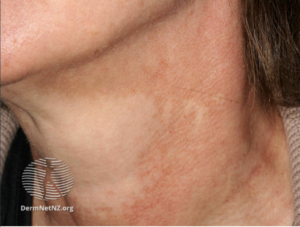Poikiloderma of Civatte

Poikiloderma of civatte is a chronic benign skin condition. It is characterised by a triad of skin atrophy, hyper\hypopigmentation and telangiectasia. It is most commonly seen in middle aged fair-skinned people, especially postmenopausal ladies.
Etiology:
The main etiology behind this skin condition is unknown. However, there are some factors that contribute to its occurrence. Among these factors, sun exposure is thought to be the most significant. Other factors include: Hormonal changes (low estrogen levels), genetic predisposition and being repeatedly exposed to photosensitizing components of cosmetics and perfumes.
Clinical presentation:
Clinically, poikiloderma presents as a rash that affects mainly the sun-exposed areas, such as the neck and the lateral aspects of the cheeks, usually sparing the shaded area under the chin. It is characterised by confluent reddish-brown patches with atrophy of the involved area. Poikiloderma is mostly asymptomatic, but patients could present with mild burning, itching, or episodes of flushing.
Treatment:
Poikiloderma is a chronic, irreversible skin condition. It responds poorly to available treatments. Most importantly, the patient should be educated regarding the importance of avoiding sun exposure, and should be encouraged to apply sunscreen. They should also avoid all perfumes on or near the affected site, including scented soaps. Treatment options that could help improve the condition include:
- Hydroquinone
- Hydrocortisone cream
- Topical retinoids can be of benefit if used for about a year.
- Alpha hydroxy-acids may help reduce pigmentation.
- Pulsed dye laser treatment and intense pulsed light (IPL) used to reduce the telangiectasia and pigmentation
- Fractional nonablative laser treatment could improve the vascular, pigmented and textural components of poikiloderma of Civatte.
Written by: Rema Aldihan, medical intern.
Reference:
dermnetnz.org
